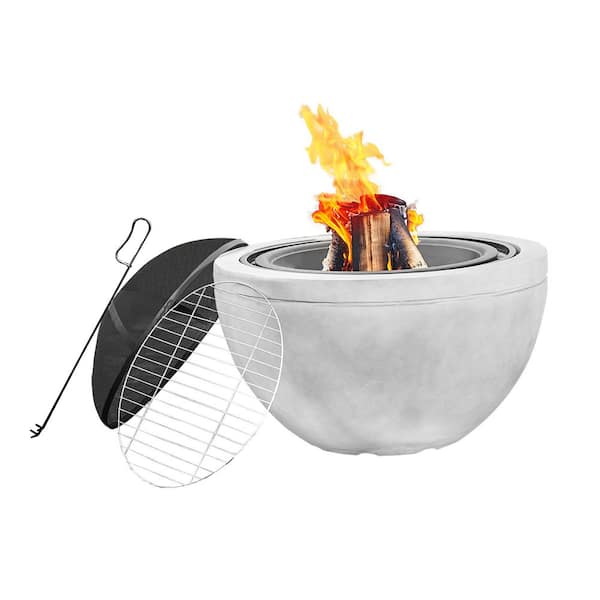What Rocks Should Not Be Used in a Fire Pit: Avoid These
Rocks that contain water or expand when heated, such as river rocks and lava rocks, should not be used in a fire pit. Fire pits are a popular addition to outdoor spaces, providing warmth and ambiance for gatherings. However, not all rocks are suitable for use in fire pits. River rocks have the potential to explode when heated due to the water they contain, while lava rocks can crack or shatter as they expand with heat. It is important to choose non-porous, heat-resistant rocks like granite or pumice for a safe and enjoyable fire pit experience. Understanding The Risks Of Using Wrong Rocks Selecting the right rocks for your fire pit is crucial to prevent potential risks. Avoid using rocks that are susceptible to cracking or exploding when exposed to high temperatures. Make sure to choose non-porous rocks like lava rocks or fire glass for a safe and enjoyable fire experience. Fire Pit Safety Basics: Hazards of Using Improper Rocks in Fire Pits: Using the right rocks in a fire pit is crucial to maintain fire pit safety. Understanding the hazards associated with using improper rocks can prevent accidents, injuries, and property damage. By choosing heat-resistant rocks, avoiding chemical reactions, and being mindful of other risks, you can enjoy a safe and enjoyable fire pit experience. Always remember to research and consult experts to ensure your fire pit is designed and maintained in line with safety guidelines. Stay safe and enjoy the warmth and beauty of a well-built fire pit. Rocks To Avoid In Fire Pits Avoid using rocks such as pebbles, river rocks, and glass rocks in fire pits as they can explode or pop when exposed to high temperatures. These rocks can pose a safety hazard and should be avoided for a safer and enjoyable fire pit experience. When it comes to choosing rocks for your fire pit, it’s essential to consider the type of rocks you use. Some rocks may not be suitable due to their properties or potential risks they pose. In this section, we’ll discuss the rocks you should avoid using in fire pits and the reasons behind it. River Rocks River rocks are commonly found and used in landscaping projects, but they are not ideal for fire pits. Here’s why: Limestone Rocks Limestone rocks, often used for decorative purposes, should not be used in fire pits due to the following reasons: Shale Rocks Shale rocks, also known for their layered appearance, should be avoided in fire pits for the following reasons: When selecting rocks for your fire pit, it’s crucial to avoid using river rocks, limestone rocks, and shale rocks. These rocks have specific properties or risks associated with them that make them unsuitable for fire pit use. Opt for safer alternatives like fire-rated bricks or stones specifically designed for high-heat applications to ensure a safe and enjoyable fire pit experience for everyone. Safe Alternatives For Fire Pit Rocks Some rocks should be avoided in fire pits due to their potential to crack or explode when exposed to high temperatures. Instead, opt for safe alternatives like lava rocks, fire-resistant ceramic stones, or tempered glass. Fire Pit Glass Or Fire Glass Fire pit glass, also known as fire glass, is a popular alternative to traditional rocks for fire pits. It offers both practical and aesthetic benefits, enhancing your fire pit experience. Volcanic Lava Rocks If you prefer a more natural and decorative option for your fire pit, volcanic lava rocks are an excellent choice. They offer several advantages that make them a popular alternative to traditional rocks. Ceramic Fire Pit Stones For heat distribution and durability, ceramic fire pit stones are a top choice. They offer excellent performance while adding a touch of style to your fire pit. Remember that when choosing the best alternative for your fire pit rocks, it’s essential to consider safety, heat resistance, aesthetics, and your personal preferences. Whether you opt for fire pit glass, volcanic lava rocks, or ceramic fire pit stones, each option offers its own unique benefits for an enjoyable and visually appealing fire pit experience. How To Choose Suitable Rocks For Fire Pits Choosing suitable rocks for fire pits is crucial for safety. Avoid using rocks like river rocks, shale, limestone, or sandstone as they can explode when exposed to high heat. Opt for rocks like lava rocks, granite, or basalt for a reliable and enjoyable fire pit experience. When it comes to fire pits, choosing the right rocks is essential for safety and optimum performance. Not all rocks are suitable for fire pits, as some can crack or even explode under high heat. In this section, we will discuss the key factors to consider when selecting rocks for your fire pit, ensuring a safe and enjoyable experience. Consider The Heat Resistance Of Rocks: Evaluate Porosity And Water Absorption: Ensure Rocks Are Non-Toxic And Chemical-Free: Remember, safety should always be the top priority when choosing rocks for your fire pit. By considering the heat resistance, porosity, water absorption, and toxicity of rocks, you can ensure a safe and enjoyable experience around the fire. Proper Handling And Maintenance Of Fire Pit Rocks Proper handling and maintenance of fire pit rocks is crucial to ensure a safe and enjoyable experience. It is important to avoid using rocks that are prone to exploding or releasing harmful toxins when exposed to high heat, such as river rocks, beach rocks, or lava rocks. Stick to rocks specifically designed for fire pits, like fire-rated stones or lava glass rocks, for a worry-free and long-lasting fire pit setup. Fire pit rocks serve both functional and aesthetic purposes in enhancing the ambiance of your outdoor gatherings. However, it is important to handle and maintain these rocks properly to ensure their longevity and safety. Regular inspection and replacement, cleaning and removing ashes, and storing rocks properly to avoid moisture damage are crucial aspects to consider. Let’s delve into each of these factors to ensure your fire pit rocks are in optimal condition. Regular Inspection And
What Rocks Should Not Be Used in a Fire Pit: Avoid These Read More »






